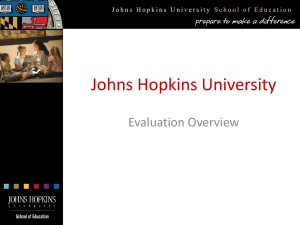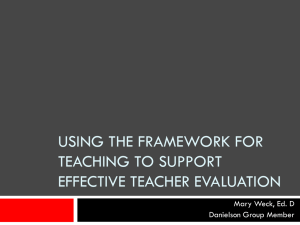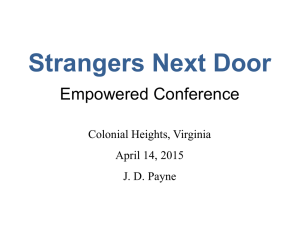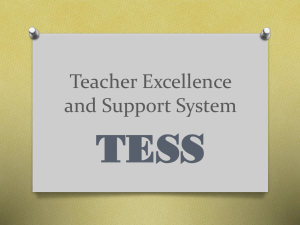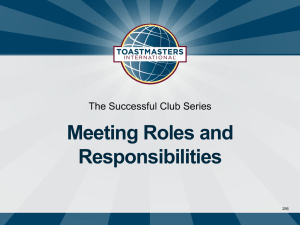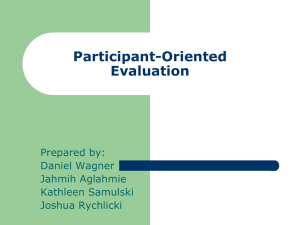Lecture Two: Evaluation Models
advertisement
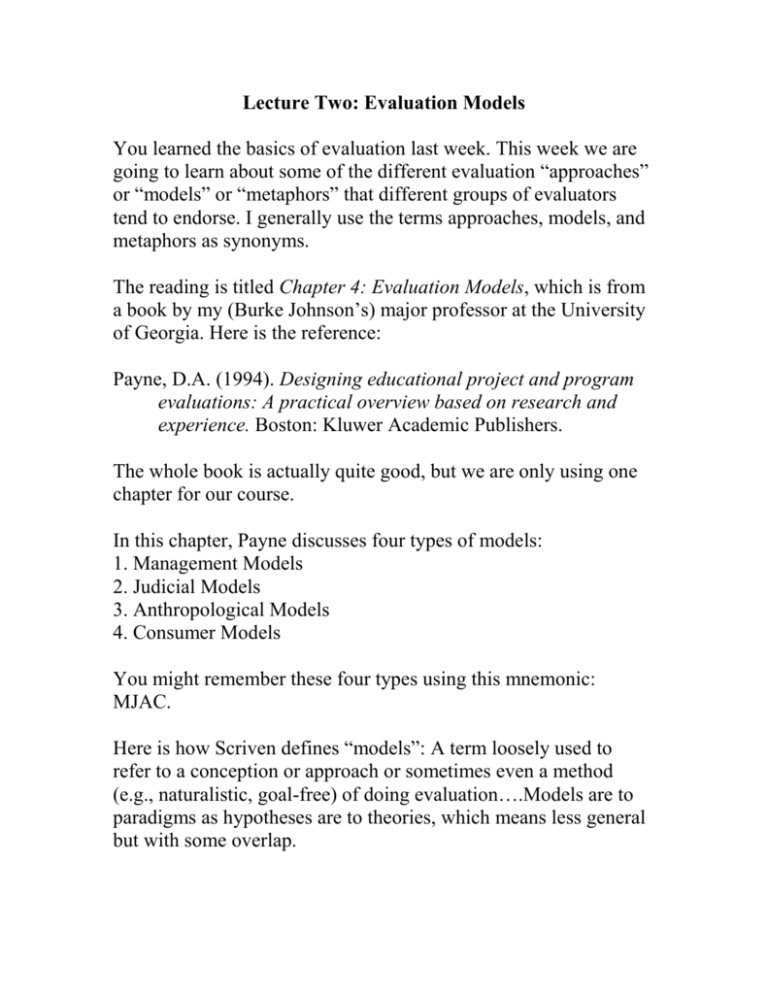
Lecture Two: Evaluation Models You learned the basics of evaluation last week. This week we are going to learn about some of the different evaluation “approaches” or “models” or “metaphors” that different groups of evaluators tend to endorse. I generally use the terms approaches, models, and metaphors as synonyms. The reading is titled Chapter 4: Evaluation Models, which is from a book by my (Burke Johnson’s) major professor at the University of Georgia. Here is the reference: Payne, D.A. (1994). Designing educational project and program evaluations: A practical overview based on research and experience. Boston: Kluwer Academic Publishers. The whole book is actually quite good, but we are only using one chapter for our course. In this chapter, Payne discusses four types of models: 1. Management Models 2. Judicial Models 3. Anthropological Models 4. Consumer Models You might remember these four types using this mnemonic: MJAC. Here is how Scriven defines “models”: A term loosely used to refer to a conception or approach or sometimes even a method (e.g., naturalistic, goal-free) of doing evaluation….Models are to paradigms as hypotheses are to theories, which means less general but with some overlap. Payne notes (p.58) that his four metaphors may be helpful in leading to your theory of evaluation. In fact, this is something I want you to think about this semester: what is YOUR theory of evaluation. Note: Marvin Alkin’s (1969) definition of program theory on p.58 of Payne’s chapter and compare it with Will Shadish’s definition of program theory on page 33 in RFL. I suggest that you memorize Shadish’s definition of program theory. I am a strong advocate of evaluators being aware of their evaluation theory. In short, you may wish to pick one model as being of most importance in your theory of evaluation. On the other hand, I my theory of evaluation is a needs based or contingency theory of evaluation. (By the way, I am probably most strongly influenced by Will Shadish’s evaluation writings.) In short, I like to select the model that best fits the specific needs or situational characteristics of the program evaluation I am conducting. Payne makes some similar points in the last section of the chapter in the section titled “Metaphor Selection: In Praise of Eclecticism.” Now I will make some comments about each of the four approaches to evaluation discussed by David Payne. I will also add some thoughts not included by Payne. 1. Management Models The basic idea of the management approach is that the evaluator’s job is to provide information to management to help them in making decisions about programs, products, etc. The evaluator’s job is to serve managers (or whoever the key decision makers are). One very popular management model used today is Michael Patton’s Utilization Focused Evaluation. (Note that Patton’s model is not discussed in Payne’s chapter. You may want to examine the appendix of RFL for pages where Patton’s model is briefly discussed.) Basically, Patton wants evaluators to provide information to primary intended users, and not to even conduct an evaluation if it has little or no potential for utilization. He wants evaluators to facilitate use as much as possible. Patton’s motto is to “focus on intended use by intended users.” He recommends that evaluators work closely with primary intended users so that their needs will be met. This requires focusing on stakeholders’ key questions, issues, and intended uses. It also requires involving intended users in the interpretation of the findings, and then disseminating those findings so that they can be used. One should also follow up on actual use. It is helpful to develop a utilization plan and to outline what the evaluator and primary users must do to result in the use of the evaluation findings. Ultimately, evaluations should, according to Patton, be judged by their utility and actual use. Patton’s approach is discussed in detail in the following book: Patton, M.Q. (1997). Utilization-focused evaluation: The new century text. Thousand Oaks, CA: Sage. The first edition of Patton’s Utilization-focused evaluation book was published in 1978. Another current giant in evaluation that fits into the management oriented evaluation camp is Joseph Wholey, but I will not outline his theory here (see, for example his 1979 book titled Evaluation: Promise and Performance, or his 1983 book titled Evaluation and Effective Public Management, or his edited 1994 book titled Handbook of Practical Program Evaluation.). Now I will make a few comments on the only management model discussed by Payne (i.e., the CIPP Model). Daniel Stufflebeam’s CIPP Model has been around for many years (e.g., see Stufflebeam, et al. 1971), and it has been very popular in education. The CIPP Model is a simple systems model applied to program evaluation. A basic open system includes input, process, and output. Stufflebeam added context, included input and process, and relabeled output with the term product. Hence, CIPP stands for context evaluation, input evaluation, process evaluation, and product evaluation. These types are typically viewed as separate forms of evaluation, but they can also be viewed as steps or stages in a comprehensive evaluation. Context evaluation includes examining and describing the context of the program you are evaluating, conducting a needs and goals assessment, determining the objectives of the program, and determining whether the proposed objectives will be sufficiently responsive to the identified needs. It helps in making program planning decisions. Input evaluation includes activities such as a description of the program inputs and resources, a comparison of how the program might perform compared to other programs, a prospective benefit/cost assessment (i.e., decide whether you think the benefits will outweigh the costs of the program, before the program is actually implemented), an evaluation of the proposed design of the program, and an examination of what alternative strategies and procedures for the program should be considered and recommended. In short, this type of evaluation examines what the program plans on doing. It helps in making program structuring decisions. Process evaluation includes examining how a program is being implemented, monitoring how the program is performing, auditing the program to make sure it is following required legal and ethical guidelines, and identifying defects in the procedural design or in the implementation of the program. It is here that evaluators provide information about what is actually occurring in the program. Evaluators typically provide this kind of feedback to program personnel because it can be helpful in making formative evaluation decisions (i.e., decisions about how to modify or improve the program). In general, process evaluation helps in making implementing decisions. Product evaluation includes determining and examining the general and specific outcomes of the program (i.e., which requires using impact or outcome assessment techniques), measuring anticipated outcomes, attempting to identify unanticipated outcomes, assessing the merit of the program, conducting a retrospective benefit/cost assessment (to establish the actual worth or value of the program), and/or conducting a cost effectiveness assessment (to determine if the program is cost effective compared to other similar programs). Product evaluation is very helpful in making summative evaluation decisions (e.g., What is the merit and worth of the program? Should the program be continued?) (By the way, formative evaluation is conducted for the purpose of improving an evaluation object (evaluand) and summative evaluation is conducted for the purpose of accountability which requires determining the overall effectiveness or merit and worth of an evaluation object. Formative evaluation information tends to be used by program administrators and staff members, whereas summative evaluation information tends to be used by high level administrators and policy makers to assist them in making funding or program continuation decisions. As I mentioned earlier (in lecture one), the terms formative and summative evaluation were coined by Michael Scriven in the late 1960s.) Thinking of the CIPP Model, input and process evaluation tend to be very helpful for formative evaluation and product evaluation tends to be especially helpful for summative evaluation. Note, however, that the other parts of the CIPP Model can sometimes be used for formative or summative evaluative decisions. For example, product evaluation may lead to program improvements (i.e., formative), and process evaluation may lead to documentation that the program has met delivery requirements set by law (i.e., summative). As you can see, the CIPP Evaluation Model is quite comprehensive, and one would often not use every part of the CIPP Model in a single evaluation. On the other hand, it would be fruitful for you to think about a small program (e.g., a training program in a local organization) where you would go through all four steps or parts of the CIPP Model. (Again, there are two different ways to view the CIPP model: first as four distinct kinds of evaluation and second as steps or stages in a comprehensive evaluation model.) The CIPP Model is, in general, quite useful in helping us to focus on some very important evaluation questions and issues and to think about some different types or stages of evaluation. Interestingly, Stufflebeam no longer talks about the CIPP Model. He now seems to refer to his approach as Decision/AccountabilityOriented Evaluation (see Stufflebeam, 2001, in the Sage book titled Evaluation Models). (By the way, I generally do not recommend Stufflebeam’s recent book titled Evaluation Models because he tends to denigrate other useful approaches (in my opinion) while pushing his own approach. In contrast, I advocate an eclectic approach to evaluation or what Will Shadish calls needs based evaluation; needs based evaluation is based on contingency theory because the type of evaluation needed in a particular time and place is said to be contingent upon many factors which must be determined and considered by the evaluator.) 2. Judicial Models Judicial or adversary-oriented evaluation is based on the judicial metaphor. It is assumed here that the potential for evaluation bias by a single evaluator cannot be ruled out, and, therefore, each “side” should have a separate evaluator to make their case. For example, one evaluator can examine and present the evidence for terminating a program and another evaluator can examine and present the evidence for continuing the program. A “hearing” of some sort is conducted where each evaluator makes his or her case regarding the evaluand. In a sense, this approach sets up a system of checks and balances, by ensuring that all sides be heard, including alternative explanations for the data. Obviously the quality of the different evaluators must be equated for fairness. The ultimate decision is made by some judge or arbiter who considers the arguments and the evidence and then renders a decision. One example, that includes multiple “experts” is the so called blueribbon panel, where multiple experts of different backgrounds argue the merits of some policy or program. Some committees also operate, to some degree, along the lines of the judicial model. As one set of authors put it, adversary evaluation has “a built-in metaevaluation” (Worthen and Sanders, 1999). A metaevaluation is simply an evaluation of an evaluation. By showing the positive and negative aspects of a program, considering alternative interpretations of the data, and examining the strengths and weaknesses of the evaluation report (metaevaluation), the adversary or judicial approach seems to have some potential. On the other hand, it may lead to unnecessary arguing, competition, and an indictment mentality. It can also be quite expensive because of the requirement of multiple evaluators. In general, formal judicial or adversary models are not often used in program evaluation. It is, however, an interesting idea that may be useful on occasion. 3. Anthropological Models Payne includes under this heading the “qualitative approaches” to program evaluation. For a review of qualitative research you can review pages 17-21 and Chapter 11 in my research methods book (Educational Research by Johnson and Christensen). (Remember that IDE 510 or a very similar course is a prerequisite for IDE 660.) Briefly, qualitative research tends to be exploratory, collect a lot of descriptive data, and take an inductive approach to understanding the world (i.e., looking at specifics and then trying to come up with conclusions or generalizations about the what is observed). Payne points out that you may want to view the group of people involved in a program as forming a unique culture that can be systematically studied. Payne treats several approaches as being very similar and “anthropological” in nature, including “responsive evaluation” (Robert Stake’s model), “goal-free evaluation” (developed by Scriven as a supplement to his other evaluation approach), and “naturalistic evaluation” (which is somewhat attributable to Guba and Lincoln, who wrote a 1985 book titled Naturalistic Evaluation). Again, what all these approaches have in common is that they tend to rely on the qualitative research paradigm. In all of these approaches the evaluator “enters the field” and observes what is going on in the program. Participant and nonparticipant observation are commonly used. Additional data are also regularly collected (e.g., focus groups, interviews, questionnaires, and secondary or extant data), especially for the purpose of triangulation. The key to Scriven’s goal-free evaluation is to have an evaluator enter the field and try to learn about a program and its results inductively and without being aware of the specific objectives of the program. Note that Scriven’s approach is useful as a supplement to the more traditional goal-oriented evaluation. Goal free evaluation is done by a separate evaluator, who collects exploratory data to supplement another evaluator’s goal-oriented data. Payne next lists several strengths of qualitative evaluation. This list is from a nice book by Michael Patton (titled How to Use Qualitative Methods in Evaluation). Qualitative methods tend to be useful for describing program implementation, studying process, studying participation, getting program participants’ views or opinions about program impact, and identifying program strengths and weaknesses. Another strength is identifying unintended outcomes which may be missed if you design a study only to measure certain specific objectives. Next, Payne talks about Robert Stake’s specific anthropological model, which is called “Responsive Evaluation.” (By the way, Robert (Bob) Stake also has a recent book on case study research which I recommend you add to your library sometime (titled The Art of Case Study Research, Sage Publications, 1997).) Stake uses the term responsive because he wants evaluators to be flexible and responsive to the concerns and issues of program stakeholders. He also believes that qualitative methods provide the way to be the most responsive. He uses a somewhat derogatory (I think) term to refer to what he sees as the traditional evaluator. In particular, he labels the traditional evaluation approach preordinate evaluation, which means evaluation that relies only on formal plans and measurement of pre-specified program objectives. In explaining responsive evaluation, Stake says “an educational evaluation is responsive evaluation if it orients more directly to program activities than to program intents; responds to audience requirements for information; and if the different valueperspectives present are referred to in reporting the success and failure of the program” (Stake, 1975). Payne also shows Stake’s “events clock” which shows the key evaluation activities and events, while stressing that they do not have to be done in a predetermined or linear order. Flexibility is the key. Go where the data and your emerging conclusions and opportunities lead you. Ultimately, the responsive evaluator prepares a narrative or case study report on what he or she finds, although it is also essential that the responsive evaluator present findings informally to different stakeholders during the conduct of the study to increase their input, participation, “buy-in,” and use of findings. As you can see, responsive evaluation is very much a participatory evaluation approach. On page 74 Payne lists some strengths and weaknesses of the Anthropological evaluation approach. He also gives a nice real world example of an evaluation using the responsive approach. 4. Consumer Models The last approach discussed by Payne is the consumer approach. The primary evaluation theorist behind this approach is Michael Scriven. Obviously this approach is based on the consumer product metaphor. In other words, perhaps evaluators can obtain some useful evaluation ideas from the field of consumer product evaluation (which is exemplified by the magazine Consumer Reports). As Payne mentions, the consumer approach is primarily summative. For example, when you read Consumer Reports, your goal is to learn if a product is good or not and how well it stacks up against similar products and whether you want to purchase it. In short, you are looking at the merit and worth (absolute and relative) of a particular product. Note, however, that it is much more difficult to evaluate a social or educational program that it is to evaluate, for example, an automobile or a coffee maker. With an automobile or a coffee maker, you can easily measure its specifications and performance. A social program is a much more complex package, that includes many elements and that requires an impact assessment using social science research techniques to determine if the program works and how it works. Payne includes an excellent checklist (developed by Scriven, and sometimes called an evaluation checklist) that you may want to use when you are evaluating any type of evaluand (i.e., not just consumer products). As Payne points out, the consumer approach also holds some promise for developing lists of programs that work, which can be used by policy makers and others when developing or selecting programs for specific problems. Payne also discuss the process of how a program could get on to such a list.
